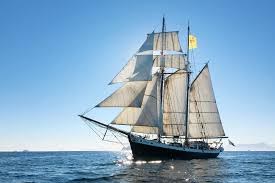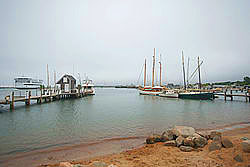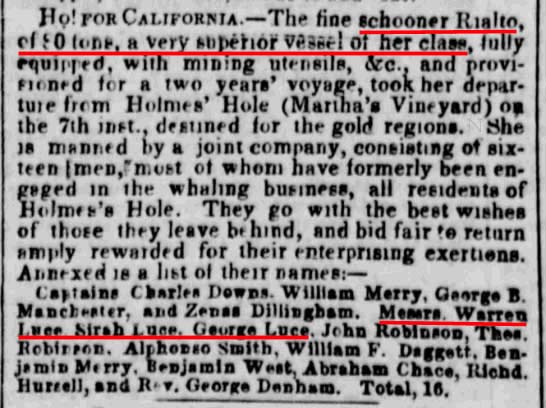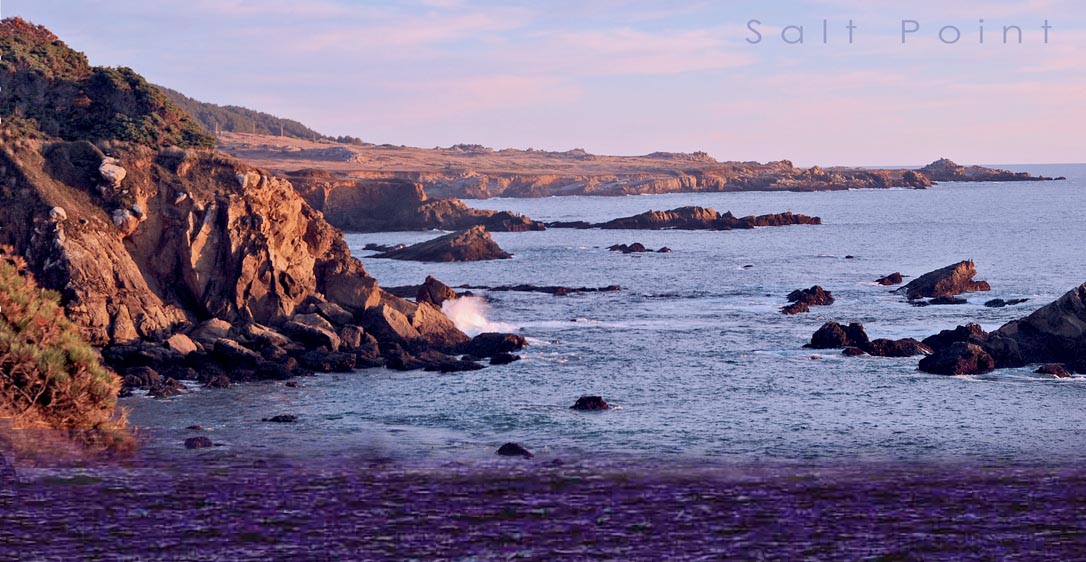 Hello and welcome
|
|||||||||||||||||||||||||||||||||||||||||||||||||||||||
|
WEBSITE CONTENTS:
This website will discuss four topics. 1. The first will be a review of the doghole schooner and its forgotten place in California maritime history. 2. A second topic is a small amount of family history. It seems my family history is entangled with the California north coast marine history far more than I ever understood. 3. A third topic is the discovery of an amazing model on our bookcase - with the help of the San Francisco Maritime Museum - skip to the old model. 4. A fourth subject is the development of an accurate doghole schooner model - skip to the doghole model in process. "CONTACT ME" is at the bottom of this page - skip to CONTACT ME. |
| SECTION 1 - INTRODUCTION
Most of my knowledge and enthusiasm for doghole schooners came from inspiration caused by a NOAA article by Dr. Delgado describing a lost class of ships referred the west coast "doghole schooner". The article is here: doghole ports co-authored by Dr. Delgado. A doghole schooner is a specific design and and has a very specific purpose. They are usually over 50 feet in length and less than 100. They have an extremely shallow draft for their beam. The beam of a dogholer is generally one third of the length. So a typical "dogholer" would be 75 feet in length and would have a 25 foot beam with a draft less than 7 feet, loaded with a full cargo.This is a dogholer in a race in San Francisco Bay... |
Introduction continued...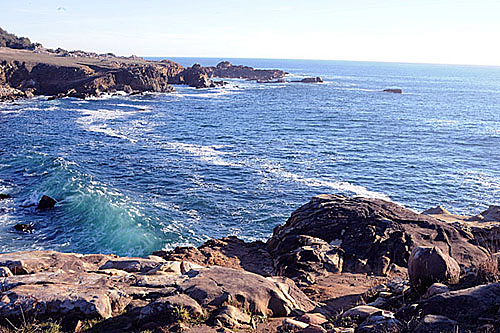
A view of a typical dogholer port entryThe port above was originally quarried for a highly compressed sandstone but a rock that can be split almost like wood into blocks. These blocks were used to build mid-sized buildings in San Francisco. This port and surrounding land is called Salt Point.Later this port was used simply for supplies to people in the area and for some lumber. A good captain and crew could place the doghole schooner in most small ports several times a day. The photo below on the left is another port shown with a simulated schooner in the port. The only entrance and exit in the photo below is to the right (west, then north)!A captain or owner of a modern 60 to 100 foot, deep keel, schooner yacht at 75 to 150 tons would enter the "port" they see in the photo to the right. But doghole schooner captains and crew did this commonly with shallow draft, schooners, and a lot of skill, and years of experience!I have carefully described my evolution and ultimately my discovery of a family model and the model's real value. The model discovery is described below. I am really trying to raise awareness of the great period of California development where doghole schooners, captains, and crews, made of steel, supplied critical perishables to isolated coastal communities in all weather conditions. And the scattered population centers of the north coast of the state assisted in this supply process.See below for more on doghole schooner evolution and history. |
| More on doghole schooners A good example of a schooner in the Fort Ross port is simulated below using a photo shop insertion process. Add occasional extreme weather, variable winds in the port, almost constant fog, significant tides, and a very tough and captain and crew and you have a doghole schooner and crew - at work. The red arrow points to a doghole schooner anchorage point still held on the surface by a float. 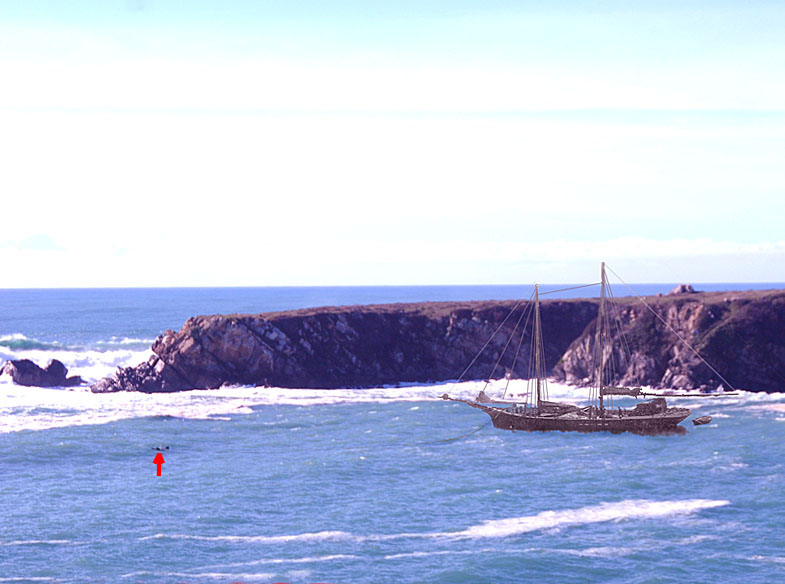
The photo above is a typical entrance for a doghole schooner. I was standing on the suthern edge of this port taking this photo. I used a wide angle lens, so this port is much smaller that it looks in the photo above. Imagine a modern 80 foot, 150 ton, two masted schooner entering this narrow entrance, turning around in the port, anchoring, getting loaded with, or unloading cargo. Then sailing out and facing an almost standard 20 MPH wind from the North with sudden and surprise calms along the coast - that was doghole schooner sailing! Continued above right... | Dogholers Continued... A doghole schooner was usually quite fast and could handle most Pacific coast weather. There was never a problem with hurricanes (Typhoons in the Pacific) because they almost never hit the north west coast of California. Gail force winds along the coast do happen and could occasionally sink a schooner or at least part the lines and leave the schooner adrift. Dogholers were initially built to carry lumber from redwood and fir forests of Northern California. Many of the ports were very small and some rocks along the edges of the port were in and out of sight depending on the wind and tides. Winds were predominantly from the north east. This made sailing down (south bound) the coast easy. Sailing north in a strong north east wind might take days and sometime weeks. General good use of a schooner required a very tough and seasoned captain and crew. Although I am a newbie to the large craft sailing world, I have been studying the doghole schooners for more than two years trying to get ready to build an accurate model. I do have a small knowledge of the schooners and I will know a lot more in the next year or so after I have shaped a number of hulls of solid wood by hand. I also found, through the help of the San Francisco Maritime Museum, that I have a very special model sloop. The sloop will be discussed later in text below. Because the model I have is so special, I have become very interested in California coast maritime history. By the way, the largest single loss of the doghole schooners in the 1850s to 1900s was anchorage parting - breaking the of lines holding the schooners at anchorage - especially in storms!The details of my family history may be a little tedious but it is entangled in local maritime history. |

| DOGHOLE SCHOONERS, WHAT THEY DID, AND HOW... This is a
website dedicated to schooners primarily used in
northern California in the 1850 to 1900 period. The
name "doghole schooners" refers to the size of the
schooner and the very small and shallow ports they
were able to access. Most of the schooners had a very
wide beam. A typical ratio would be three to one,
length to beam. So a 75 foot dogholer would have a 25
foot beam! The actual name, “doghole ports,” was so named because they were so small and exposed that mariners joked they were barely large enough for a dog to turn around (in) (note1). 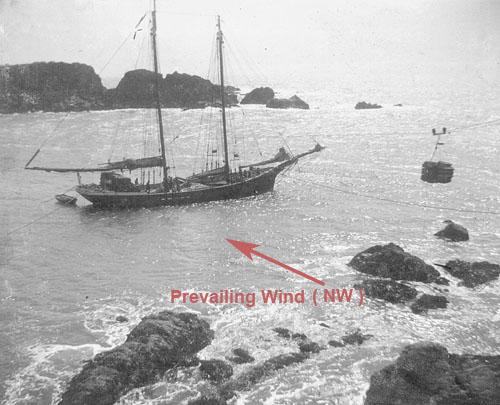 Another
term for this type of schooner is simply "Lumber Schooner". But as these
schooners evolved in the 1850s to 1880s and they developed a very specific
style such as an extremely shallow draft and very wide beam. But in deep water, that same
shallow draft could allow the vessel to drift sideways. The dogholer
was limited to courses very close to the shoreline but well away from
the rocks of the California coast. This coast is over what is known as a shelf in
geological terms but highly modified by the San Andras Fault. Some
areas such as Salt Point shown in the top image. The rocks which look as though they were dumped there, WERE formed there by the San Andras fault, which can be very active. Most of the time the San Andras is quiet and safe, in the north coast area. Another
term for this type of schooner is simply "Lumber Schooner". But as these
schooners evolved in the 1850s to 1880s and they developed a very specific
style such as an extremely shallow draft and very wide beam. But in deep water, that same
shallow draft could allow the vessel to drift sideways. The dogholer
was limited to courses very close to the shoreline but well away from
the rocks of the California coast. This coast is over what is known as a shelf in
geological terms but highly modified by the San Andras Fault. Some
areas such as Salt Point shown in the top image. The rocks which look as though they were dumped there, WERE formed there by the San Andras fault, which can be very active. Most of the time the San Andras is quiet and safe, in the north coast area. Blue water schooners, even at
80 feet in length have deep keels and a draft too deep to
access any but the largest of ports such as San
Francisco Bay. They were limited to the deep water
ports of California because of their deep drafts (ship's depth in the water).
 To the left is a 75 foot, 64 Ton schooner (inserted using PhotoShop as a simulation), with a minimal keel, and a 5 foot draft. The typical doghole schooner came into the port and maneuvered under sail and people power alone. In this port photo the rocks seen behind the masts are continuous and on three sides of the schooner. Basically this is a "U" shaped port. This NW wind (wind from the North west) direction is almost constant so departure would be north directly into the wind. There were anchorage
points around the schooner to hold her in fair
weather but would not hold in heavy storms.
The schooner could hold cargo usually
lumber products and sometimes 2 to 3 passengers - more passengers
if they were VERY good friends. Depending on the placement of the
schooner in the port. This is a modified color image is to to
illustrate the realities of the shipment of materials and the delivery
of occasional passengers.
Below is a photo of a schooner being
placed under a chute. These chutes loaded lumber by gravity and the
lumber speed control process was critical. With an aft cabin, lumber
was loaded to the forward ares then amidships, then on both sides of
the cabin. Sometimes the lumber was loaded to just below the aft boom.
The northern rocks to the port can be seen in a color enlargement at
the top of the section.
THE CHUTE
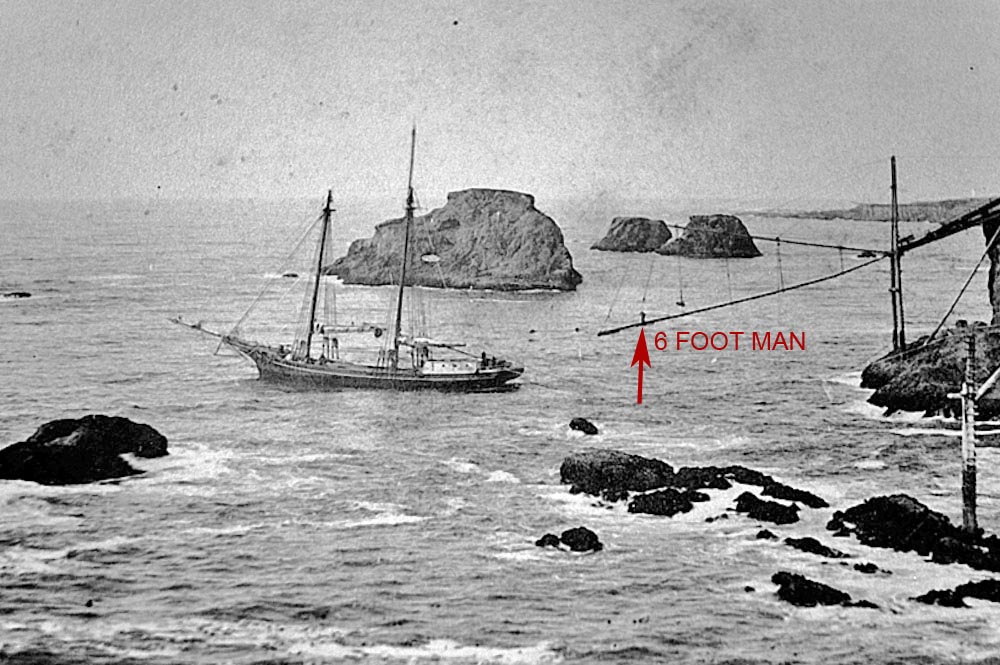 Aligning a visiting schooner to this port's cargo chute
1Doghole Ports on the NOAA Office of National Marine Sanctuaries site at https://sanctuaries.noaa.gov/maritime Maritime Cultural Landscape initiative supports targeted research in the Greater Farallones National Marine Sanctuary. This study of dogholers and the discovery of my model sloop was an amazing series of events and certainly got me started in maritime history in the SF Bay Area. The website listed above has a lot to describe and teach in there articles! The articles ALONE on the website help find an important "model" I had from that time, which my wife and I donated to the Maritime museum as a gift. One article/project led to a new maritime artifact discovery of significant value! Thank you for funding that project!!! The Article also caused me to create this website - a kind of "pass it on" process. |

STRANGE BUT TRUE - AN AMAZING STORY
A very small craft survives 140 years - a little family history connected to these schooners and sloops
PART 1
Background and origin information - What is a doghole schooner?
|
These
schooners were developed to provide
provisions and general trade to north west
coast area which was not developed in 1850.
The gold rush caused even more needs for
supplies. The usual methods of supply such
as rail and roadways were not developed to
the coastal ares of California.
Finally the wreck of the China clipper Frolic on the north coast left massive amounts of commercial goods near the wreck but with no way to get the salvaged goods to San Francisco. During salvage attempts, the massive redwood forests were discovered along the coastal areas. The redwood timber was of much higher potential value then the salvage of the Frolic. But still now way to market except by ship. A small, shallow draft schooner was developed for the 1850 period of trade in California. These schooners were incredibly agile and fast. From 1850 to 1900 they thrived along the California coast. continued above right... |
|
Part
1 continued These schooners, as long as 110 feet, could enter and anchor in very small ports call doghole ports. The details and a photo are shown above. By 1900 steam power was taking over in commercial shipping and rail and roads were developed by 1900 so the doghole schooners were abandoned to cheaper shipping costs and very sadly, the schooners were lost to time. Today all but photos are left for people to see to and understand the amazing schooners developed from 1850 to 1900. Model building is almost impossible for lack of drawings and models of the time. From all that I can find there is a single half model of the schooner "Maid of Orleans" kept at the Maritime Museum at San Francisco. There are no drawings or documentation on details of these schooners. The history is completely barren - nothing - not even a sketch. |
PART 2
A Great Paper And An Inspiration |
||
| I happened to read a recent
paper on doghole schooners, anchorages, and the
chutes used to move cargo and people. One of the directors of this project and authors of this report is Dr. James Delgado. I wrote to Dr. Delgado and explained my connection to his diving and anchorage work and we have become friends as I report on my experiences with my model and visiting various ports near me. Dr. Delgado is an amazing person, a fine person to write to, a teacher, and very easy to talk with. Dr. Delgado is one of two inspirations for this website project and almost directly responsible for my wife and I discovering our family model. Stephen Canright, history Curator, SF Maritime Museum was also critical in this sequence described below. continued above right... |
Part 2 continued I am not an expert or specialist in sailing craft. I do have a deep interest in the working schooners and sloops of the San Francisco area especially in the 1850 to 1900 period. I do have an unusual insight into boats of this type and time. Please forgive a fairly boring description of my family history and the Howland family history but it does become amazing and important as you see the pieces of this story merge. This Location, Ft. Ross, is especially important to me because my grandmother taught school at Fort Ross in 1906. Historically the fort was the furthest location south in the US, occupied by the Russians (1812 to 1842). This location is also the closest doghole port to my home - about twenty minutes by car. Dr. Delgado's paper is here |
|
| My
family is descended from Wales, as best records in
Britain can
confirm. This connection to of a Luce/Welsh heritage has been confirmed
by a DNA marker specific to the Luce line and has been tested and shown
to exist in my direct line of heritage. I am tractable to Henry Luce, the first Luce in this country. Henry Luce arrived in America in approximately 1640. Henry is tractable to a Welsh family in wales in the late 1500s. That Welsh family is believed to be a clan in Wales with roots going back to at least the early 1500s in Wales and probably earlier. Records for the 14th century in Wales, including clan histories, are a bit thin. Henry voted in 1644 in an American local election which is the first documented date of the Luce family line in America. I am a direct decedent of the first Luce in America. continued above right... |
Henry
Luce settled in Holmes Hole (now Tisbury), Marthas
Vineyard. The family became well established in Marthas Vineyard by the
mid 1700s. In the late 1840s, a few members of the family decided, to
take part in
the "gold
rush" of 1849 in California. Later, the Rialto was proven to be so fast and maneuverable, she was purchased and used as a pilot boat (Bar Pilots info) for ships arriving at the San Francisco Bay entrance after 1851 More on the Rialto is mentioned in an amazing ship to ship chance meeting below. |

|
PART 3 A Meeting At Sea
MARCH 15, 1849 BETWEEN
THE
"PANAMA" AND THE "RIALTO"
|
||
| From
article:
"THE LOG OF A 49er" on his trip around cape horn - Jan,
'49 to July '49 from the diary of THEO. MESSERVE. NOTE:
This is a personal log of Theo Messerve, from an 1849
trip to experience a trip around the horn on the Panama.
The captain of this ship is Captain Bodfish. This
conversation shown below is a quote from Messreve's
book. Note : This was an actual meeting of the two ships at sea where the two captains could compare locations and other position information. There might also have been an exchange of mail and news of each port. It was also an opportunity to exchange news concerning weather and sea conditions around the cape. The image above is a likeness to the Rialto. There are no known surviving photos of the Rialto. |
||
|
Book
entry as a (real-time) diary. The diary entry is as follows: "March 15
1849. She continued to draw nearer, and by ten o'clock came along near enough to talk with those on board without the aid of a trumpet. She proved to be the schooner Rialto from Edgartown, Marthas Vineyard."
Conversation shown above top
right of this section...
|
Recorded ship to ship conversation... "Where are you from?" "Edgartown, Marthas Vineyard." The ship to ship actual conversation at sea opened as follows (quoted from the Messerve Book): "Who is Captain of the Panama?" "Bodfish." "How is Captain Bodfish?" "Very well, I thank you. Who commands the Rialto? "Captain Luce." "Is Captain Luce well?" "Yes, sir" "Where are you from?" "Edgartown, Marthas Vineyard." "Where bound?" "California." (Three cheers from the Panama.) "How many days out?" "Thirty-seven. How many are you?" "Forty. Have you spoken anything?" A number of questions in relation to our latitude and longitude, the wind and weather each has experienced, follows. They have had very rough weather, and intend putting into St.Catherine's. "She dropped astern of us and then came around to windward." "We gave them three hearty cheers, which they returned, and passed by us like an arrow." She is a beautiful little schooner of 100 tons, is new, and looks beautiful with her new white sails and black hull. |
|
This account comes from a book or magazine titled "THE LOG OF A 49er" on his trip around cape horn -
Jan, '49 to July '49 from the diary of THEO.
MESSERVE. Captain Warren Luce was a distant relative of mine. One postman in Holmes Hole was heard saying - "...those Luce's are like rabbits at Holmes Hole - all over the place...". Schooner Rialto, from Holmes Hole, February 7th, 1849:Wm. Merry, Geo. B. Manchester and Zenas Dillingham, Warren Luce, Jireh. Luce,
|
||

PART 4
Family members arriving in California
Family stories about sea captains in the family and seeing the model that has become so important My grandmother lived a few miles from the area in the photo above - she was a school teacher at Ft. Ross. (a busy doghole port in the 1880s to 1920s). It is extremely likely my grandmother watched doghole schooners arrive and unload freight at the Fort Ross port. Much later, during my early
life, I remember numerous, and endless at
the age of 10, family discussions listing
relatives. I later understood the reason for
chats about family history since my mother
was deeply involved in family history, and
she had a great memory, she remembered most
relatives in amazing detail. 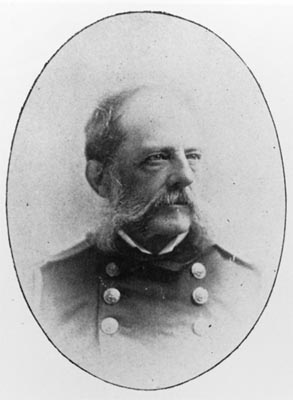 My mother helped write a massive history of
the Luce family (4 books at 700 pages each - about 3000 pages total).
There
were a number of sea captains in the family
including my namesake Admiral
Stephen Luce of whom I am very proud.
My mother helped write a massive history of
the Luce family (4 books at 700 pages each - about 3000 pages total).
There
were a number of sea captains in the family
including my namesake Admiral
Stephen Luce of whom I am very proud.There was a Captain Warren Luce (about half way down the page on this link) who worked out of Tisbury. He had a very interesting life as he describes it. Jirah Luce became the critical connection to my model and early life in California, Jireh Luce arrived in California in 1849. He was quite an entrepreneur for his time. My father and uncle were both Naval Intelligence officers, in the Pacific, during world war II. We are still checking the timing Warren Luce as he stopped off in San Francisco in 1849 apparently as the captain and also part owner of the Rialto. His account of the Rialto is that he owned it and sold it and went back to Holes Hole - gold mining was not for him. His claim was that he sold the Rialto to a San Francisco group to be used as a "Pilot Boat" in the 1850s. While visiting my grandmother as a child, I remember seeing a small model ship. I asked about the model and I was told there was a sea captain in my family and the model was related to him. continued above right... | Part 4 continued - A MODEL APPEARS IN MY LIFE There was a mention of a
Captain Wines known to my family. But this captain may have come from
the Howland family connection.
I do not remember names or where the model came from but I do remember one of those odd memories of childhood when I was told the model was given to us by Captain Wines. Later in my life I remember living with my grandmother in Berkeley while I was going to college. We had many discussions of her time at Fort Ross. I saw the model again in my grandmother's house and asked again but I do not remember any details about the model other than it was a gift to my grandmother or grandfather. But my memory of Captain Wines still is with me today. Still later my father was given the model by my grandmother when she was sorting and downsizing. My father gave the model to me when he was downsizing his house. My wife and I searched the net for more information on the model and we are continuing the search as I write this story. In my search for information on my model, I ran across a great article on San Francisco Bay Area shipping in the 1880s and this outstanding article on Doghole schooners and their ports. I studied the article and area maps for several months and still look to it for guidance on each of the doghole ports. This is an very fine article and is what got me going on doghole schooners and ultimately uncovering my model I have as a sloop very similar to larger doghole schooners. Our guess is the sloop would have been about 40 feet in length. Reading
this article and talking to Dr. Delgado
was quite an experience for me since the
front cover photo is of a doghole port
(Fort Ross) and about 20
minutes from my present house.
Thank
you Dr. Delgado!It is very important for me to say Dr. Delgado's report got me started on all that follows including understanding my model. | |
 Fence at the Call
Ranch
PART 5
So I have an interesting model but how important? |
||
| Is this model
accurate? As I have said, I became involved in the doghole schooners from the article and work of Dr. Delgado. I made a trip to the San Francisco Maritime Museum. By calling ahead, I was able to make an appointment to meet the history curator of Maritime history, Stephen Canright and visited the research center. Stephen was an excellent person to know and he was very patient with me even though I was as green as they come in Maritime history and ship knowledge. At one point in our discussions I very casually mentioned my model of a sloop. In my total ignorance of doghole schooners I said I had a model that looked something like a "dogholer" but the masts were wrong - my model only had one mast. Stephen was startled and he told me there was a whole class of one masted commercial (sloops) in the 1850 to 1920 period in the San Francisco bay area but no information on the sloops. He told me the working sloop of that time was very common before 1900 in the Bay Area. He then asked me what my model looked like and I described it and he became very interested. Being totally ignorant of San Francisco Bay Area sailing vessels, I did not understand his interest. He told me he had been researching the commercial sloop history for several years. continued above right... |
|
Part
5 continued
He had a list
of sloop names that documented the sloop
which probably numbered more than 500 in
their peak usage around 1880. But there
were very few photos and absolutely
no
technical documentation. No
drawings and no models.
Even I knew the model might be important so it started a rapid exchange of emails and photos between myself and Stephen. The model in this photo below is about 20 inches long, it has a very wide beam of 7 inches, a very shallow draft and the mast lying against the base in this photo is 20 inches long. I will show many more photos on a separate web page here I will call "model photos". Stephen Canright was so intensely interested in my model, I came back to my home in the North Bay Area and sent him a couple of photos. I suppose most model makers and sloop knowledgeable people can easily understand what this photo below means. Stephen asked me to bring the model to him at the museum. 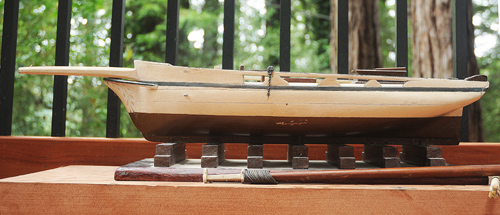
The Basic Model after so many years
|
The answer to what value? Priceless
| What
do you do with a priceless
antique?
I
made a box to carry the model and my wife and
I made a trip to the museum. When Stephen
Canright saw the model for the first time, I
could see that the model meant a great deal to
Stephen just to see it in reality - and to
examine it in detail. Stephen studied the
model and consulted a few friends and let me
know the model was authentic.
This model is an authentic and appears to be quite accurate. The model was probably built about 1880. The model was a detailed copy of the sloop to be built or a model of a sloop built in that time period. We do not know if a full sized sloop was built. The documentation of commercial sloops is difficult to find and registered sloops are rare. The model was probably built between 1860 and 1880. After making laser measurements of the hull I found the shape and detail of the hull to be extremely well done and probably quite accurate. I felt quite strongly about the model and I needed to make a decision about who was to care for it now that we had an idea of its historical value. I was told by the San Francisco Maritime Museum people that the model was "Smithsonian" or "Maritime Museum" in quality and some of my documentation concerning the model went to the State of California because they were interested also. At this point my wife and I had to decide where the model should be kept. The next place for the model would be
|
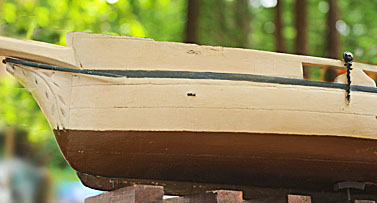 A
closer look at the bow- about 1 inch slabs of
possibly balsa
Part 6 continued We ruled out keeping it at home and looked for the best access for the public to see the model and a secure, safe location. Since the model is from California, as I am, my wife and I elected to keep the model at the San Francisco Maritime Museum. My wife and I also had to decide on trying to sell or auction the model which both my wife and I ruled out immediately - selling history would be such a loss to the sailing world except possibly to the buyer! By this time the Maritime
Museum had time to do a quick survey of the
model and told us the model is extremely
rare and very likely
the only known model of a Commercial Sloop
in the world. My point here is that
even though the Maritime Museum wanted the
model for its collection. They felt an
obligation to tell us it was very rare and
would be difficult to appraise for monetary
value.But the model was
"Smithsonian Quality"
For my wife and I it was "San Francisco Maritime Museum Quality" and that is where hoped it might be kept as a part of their collection. |
SOME SPECULATION ON MY PART It is my opinion that my great great grandfather, Jireh Luce, knew the Howland family form his early youth to adulthood in Holms hold on Marthas  Vineyard. Vineyard.I believe both families knew each other in Holmes Hole and when Jireh Luce settled in Sonoma county in the 1850s, so the Howland family settled in Napa County - about 70 miles apart. On a personal note: I have lived in both the Napa Valley and the Sonoma Valley most of my life. I know the two valleys are connected by trade and growth and even by twin rivers that both empty into the SF Bay. Both rivers can be navigated buy supply craft such as the sloop which might have been built by the Howland Family based on this model. It seems extremely likely that both families met often, and in particular, my great great grandfather Jireh met with the Howlands including John Howland - the great sea captain. My family has owned stores and supply houses for the Sonoma county area and it seems likely both families met to discuss combined valley business including shipping supply issues of the Napa/Sonoma area. at some time in the business exchanges, I believe the model shown here was given to my grandfather Jireh Luce by the Howlands. The model has been in my family since that time, which seems to be about 115 years. It is this kind of care of a special object, such as this model, that makes it so important to a great museum like the San Francisco Maritime Museum. With deepest respect, Stephen H. Luce |
PART 7
What to do with the model?
THE "MAGIC SLOOP"
(Like The Magic Flute of Mozart)
| My
wife and I considered the issue of price and
she and I easily and quickly felt there was
no way to price the model and that we would
never sell the model for cash. At this point we knew Stephen Canright was deeply involved with the model and had even written an earlier paper on the commercial sloop. His paper was written without ever seeing a 1875 vintage commercial sloop but was based on good information from Bay Area sailors who had told him of the existence of a commercial sloop and what they remember about the sloops. By the way, Stephen's description in his paper, never having seen one, was amazingly accurate. So we let Stephen Canright know what our decision was - we would donate the model to the Maritime Museum. Stephen was pleased and understood our reasoning. I asked one consideration in return and that was the model would be made a permanent part of the Maritime Museum collection. My family has given special items in the past and I later found that these "special items" were traded or sold to support the recipient organization. I understand the increasing challenges non-profits are facing but we could not stand the idea that this model would end its days in a private collection or worse - destroyed in an earthquake or fire. The Maritime Museum was very helpful and assured me that it would be entered into the permanent collection of the museum and made the agreement we signed with the museum "irrevocable". You might ask why I did not know this was authentic - answer - I have had the model my whole life and simply saw it as a beautifully shaped boat model. Now I miss it - a lot - but I did make an exact copy of the hull, in wood. continued above right... |
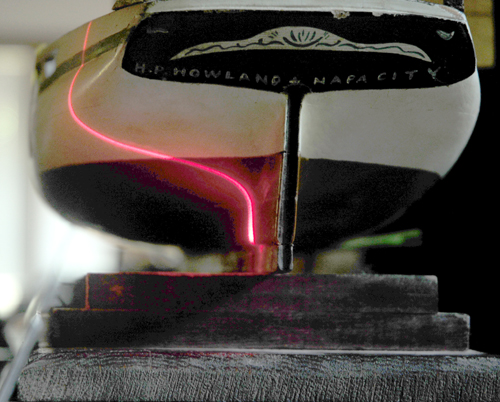 Transom area with laser line
to define the hull shape
- WHAT A BEAUTIFUL SHAPE - Part 7 continued It seems to me that eBay is a
new challenge to non-profit museums and
seeing the model on "sale" on eBay would
have been deeply hurtful to me and my
family's effort to keep the model in good
condition for 108 years. And
the Howland family for 30 years before my
family.
And the critical point is to make is that the vessel, of which this is a model was, was probably 40 feet long, and the beam would be about 12 feet. And a draft of less than 3.5 feet or draft of about 40 inches! A 40 inch draft could sail rivers of the area! This amazing hull and very shallow draft is what makes these forgotten sloops and schooners so special. Look at the complexity of the lines near the transom. When I copied this area by hand, by eye, and by feel, I realized how much effort went into the model. It is a beautiful sculpture and I love the functional and aesthetic beauty. |
Up Close - Just as the model maker made it 140 years ago
with a little aging as we all show at over 100 years.
| And now we
discover what a treasure the model is! The model has been on my shelves in various houses over the years and now it is gone. Only now do I understand what treasure it was and is. But I was a steward not an owner and now it is safe for many years to come. This model is completely original. It is just as the builder made it. No paint repair or update - ever! No major parts added or lost except the rudder, original fittings, some of bone or ivory, and even the base is as the original builder made it - no changes have been made to the model and it has never been damaged or dropped. There were a few pieces of the rigging lost. It is my guess that the model is about 148 years old. This model has been in the Luce family for 115 years. Many more images on this page: THE SLOOP MODEL photos. More detailed information on the life and history of the model on the model photograph page. In
this photo to the right, you can see a strong magnification of the
original hand applied paint with brush hair from the original builder's brush left during the painting of the model.
|
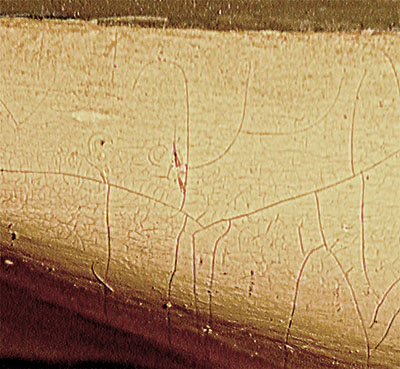 Magnified
view of the original model paint including a brush hair left by the model maker |
r
What all of this means to me - stay off the rocks maybe
After all the weeks of time I spent working with my wife to find drawings of a dogholer on the net we had no results. But after a few emails from the Maritime Museum, we found a good view of a doghole schooner and an almost complete answer was a few feet from me in our living room. I was desperate for just a side view and I had live 3-D view of a doghole hull design sitting quietly, for a 115 years in my families' various houses, and it was now in front of me!
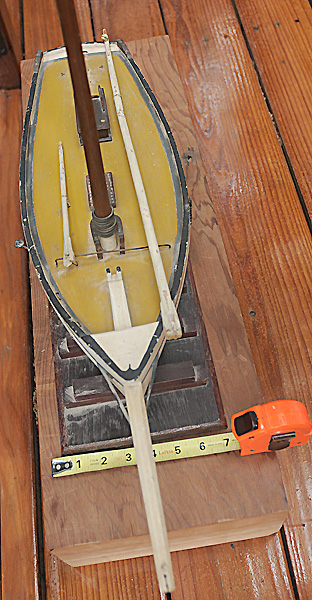
But keep in mind I have been aware of this model for more than 60 years and understanding it was a treasure took me some time to understand - it was just a good friend and had been my friend for my entire life! This was one of my earliest memories of my life - I loved this model.
When I got an email from the curator of sailing history at the San Francisco Maritime Museum telling me the model was important and to bring it to the museum as soon as possible, I began to understand this little model was important to others and it was more than just a model.
When I got an email from the curator of sailing history at the San Francisco Maritime Museum telling me the model was important and to bring it to the museum as soon as possible, I began to understand this little model was important to others and it was more than just a model.
It may be easy to see its value from these photos if you know sailing and especially if you know the history of west coast sailing but it was a total surprise to me! To me it was an extremely important model and I loved its shape but it was just a model - WRONG!!
My grandmother had the model in the San Francisco earthquake and the model survived without a scratch of damage. My grandmother told me that she woke up during the quake and rode her bed from one side of her bedroom across the room to the other side - she was shaken you might say but OK.
The 1906 San Francisco earthquake was a 7.9 and she was a few miles from the epicenter and I believe the sloop was on a shelf but survived without a scratch. Sadly, 3000 people died and over 60 to 80% of cities in the area were destroyed. The earth displacement in the area near her house was 20 fee
As I studied many hull shapes of the doghole schooner, I realized that the shape |
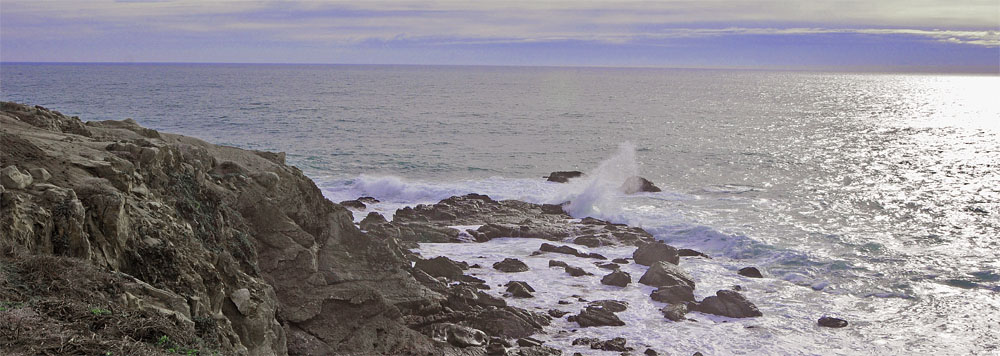
|
New
Projects
NOW THAT I HAVE AN ACCURATE, BEAUTIFUL, SCHOONER AND SLOOP SHAPE FROM WHICH TO BUILD ACCURATE MODELS, HERE ARE SOME NEW PROJECTS I AM STARTING... 1. To bring my model back to my home - in spirit.  It is my intention to first build an exact replica of the model I had - an 1880 commercial sloop but I will finish it. This will include deck and hull planks on a solid hull, deck hardware, and complete rigging to the best of my knowledge and assistance from others. This would help with the loss of my original model by moving it to the Maritime Museum, and bring it back home in a sense. 2. Do my best to enhance the knowledge of the doghole schooner for people in the future. I will also build a accurate model of a doghole schooner using my sloop and an authentic half model of a somewhat notorious part time dogholer called the "Maid of Orleans"at 110 feet. The very precious half model from which the "Maid" was actually built is in the Maritime Museum collection in San Francisco. I
will use hull lines from both ship hull
models as well as the many photos of
dogholers to make a solid hull shaped
exactly to the dimensions of the combined hulls. I
will then plank the hull with planks of
proportional size and add rigging based
on many good photos available. To
say this a different way, I have
accurate lines from a 40 foot
sloop and a 110 foot
schooner from which I hope to build a model of a 75
foot doghole model schooner.
 This
model in progress is to the right: This
model in progress is to the right: This hull shape was based on
the old photo below, right. The hull is solid redwood and
not possible to hollow until
the shaping of the hull from a laminated
solid slices
of
the
wood was completed and messing with
hollowing with a router bit is a
very dangerous process - the router bit
can break through the hull.
This hull is a typical beam which is 1/3 the length or 10 inches wide approximately - the hull is 30, inches in length. The shaping of this hull took about 2 months. The complex hull shape is a mater of a rough cut and then a LOT of sanding usually with a 60 grit. The small powered hand sander was my primary sculpting tool. Measurements on summitry were made with calipers and other tools like templates. More on the "Project 2" page It is this photo I drew much of my hull shaping from. The actual
story about the Nettie
beaching
shown below in a photo is as follows:
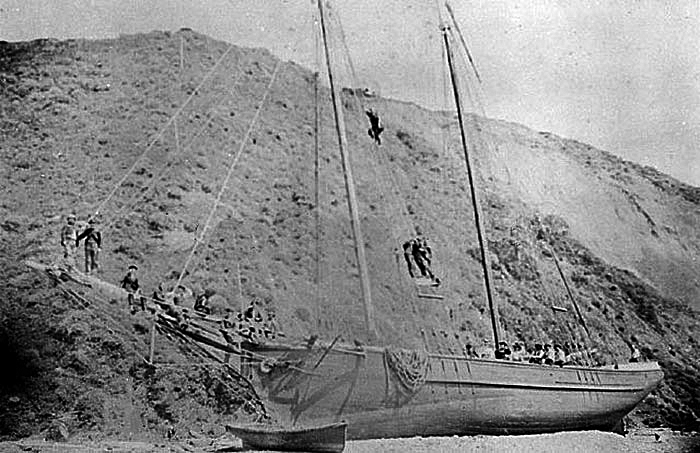 "... She was moored at the Hardy Creek Lumber Company’s dock, preparing to load bark when she broke her moorings in heavy seas. Attempts to secure the ship were unsuccessful, and with his crew safely in the riggings, Captain Johnson decided to cut the remaining stern lines and allow the ship to drift ashore. The Nettie Sundborg was subsequently repaired, and she continued operating along the Pacific Coast until she wrecked for a final time near the entrance to the Suislaw River, Oregon on December 28, 1902..." (Note 2) One question -
why the hull
bulge below the aft mast?
The old photo
above is the the Nettie Sundborg. You can see
the significant
bulge in the Nettie under the aft mast. I gave
this a lot of thought including the
possibility that the beaching could have caused the
bulge. My best guess
is that the framing is too strong and if the
aft region
of the hull was damaged by the beaching it
would have been very difficult to repair
the distortion in the hull.
If this was hull damage it would have been significant and the ship would not have floated back for repair. And for crew safety the captain would not have allowed the crew back on board to move to the repair area. The rigging is also very tight on both sides and the mast is parallel to the forward mast. And, the water line curve is very much inline with the forward line. The only other explanation is that the shape was shifted slightly from a pure ""V" shaped round bottom" to a more square shaped "round bottom" hull aft for a reason. This small change would have increased the hull capacity. To me this is a brilliant design addition. This ship also was considered one of the fastest Dogholer in the 1880 period. More design and modeling issues and model progress will be shown on the "Project 2" page which will be only concerned with this Dogholer model. Click your browser back arrow to get back to this location. 3. Find help - from good model makers and help from people who understand 19th century sailing craft. 4. Develop the best possible sources and resources. I
hope to find ways to collect any lost, or
misplaced (attics, old boxes, etc.)
documentation, models, and drawings on
doghole schooners. If I do find sources on
dogholers it very likely will help me with
my model maybe others have the same issues.
The model hull shape mates exactly with the photo and looks good when you see it from the top. 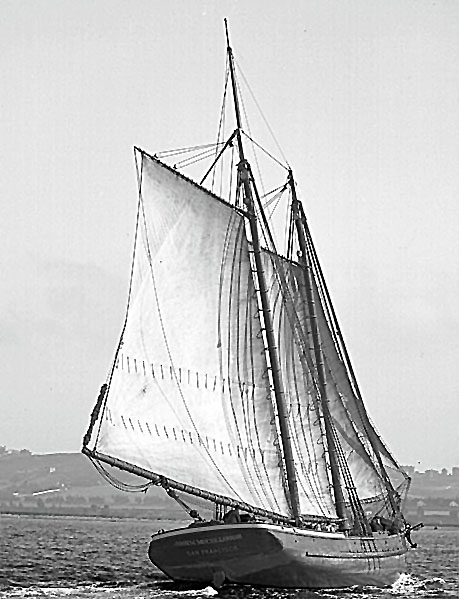
Here is a
"doghole" schooner on the San
Francisco Bay in all her
glory.
Keep in mind that this schooner has a draft of less than 5 feet. This image is what I see as a very beautiful schooner with a magnificent shape in her fast sleek but full hull - sounds like I am talking about a woman! The masts are like telephone poles and as such, are very strong and can take a very large mainsail/gaff combined! Imagine the weight of that sail in rain and what it would take to raise it. The crew on a schooner like this was three to five men. This photo to the left is a typical doghole schooner under sale. They were fast and used a lot of canvas when the winds were right. This is the "John McCullough". She was 76.5 feet long, 24 feet across the beam and displaced 72 tons.2 This dogholer in this photo was built in 1873! This image shows the beauty of the schooner under full sale in a good wind on the San Francisco Bay. This image is one of the images I am using to shape my doghole schooner model hull without drawings. A technical note...the photo above combined with the very powerful PhotoShop shows a great deal of information about a transom, waterline empty and rigging of the time. information and photo from a great website: httphttps://www.mendorailhistory.org/1_shipping/ship-info/ships_j-k.htms://www.mendorailhistory.org/1_shipping/ship-info/ships_j-k.htm (if you are interested in this photo it is under "J" for "John McCullough") Also NOTE 2:This information on the Nettie (above) is taken from the same website The photo was originally from a master photographer with his collection at the Bancroft Library in Berkeley. This photo looks good now but was taken 140 years ago probably about 1880 to 1890. This was photographed from another craft on the San Francisco Bay - amazing. This
schooner was wrecked in 1893. 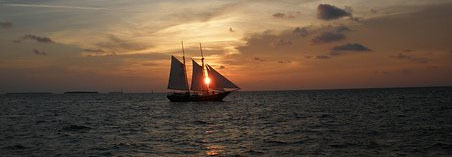 Last Thoughts
Working on the hull shape of the ghost ships - The Doghole Schooners 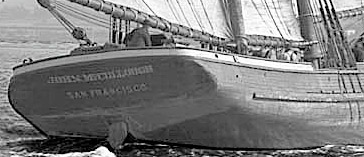
I
will be updating the model of the true
schooner which is shown below as"Project 2".
This is a slow process - it has taken almost
a year of study before even cutting a rough
blank shown on the project 2 page. The
shaping of the hull is as much sculpting as
the marine engineering and model maker
processes. Progress is hour by hour but the
model will be extremely accurate considering
the fact that there are NO
drawings
of any dogholer and that is part of the
purpose of this website.
The photo to the left is enlarged, refocused, etc. and has adjusted light details to see the transom shape and the size of the Captain to be used as an estimation of dimensions and a little about the rudder. The captain can be compared to mast thickness, planking above and below the deck line and a hint at low and high waterlines as well as scupper detail. Some mast rigging detail such as the range over which they expect the boom to be used is probably controlled by the rigging detail just above the boat name and home. She is wide in the beam and is not a "Bluenose" or an America's Cup racer but to me she is a beauty The buttons just below will open new windows on my projects related to the sloop model and the general subject of the dog hole schooner. I am presently working on a 30 inch hull of the doghole schooner based partly on this photo above in project 2. ABOUT CONTACTING ME
 WEBSITE
UNDER CONSTRUCTION
WEBSITE
UNDER CONSTRUCTION
 |
